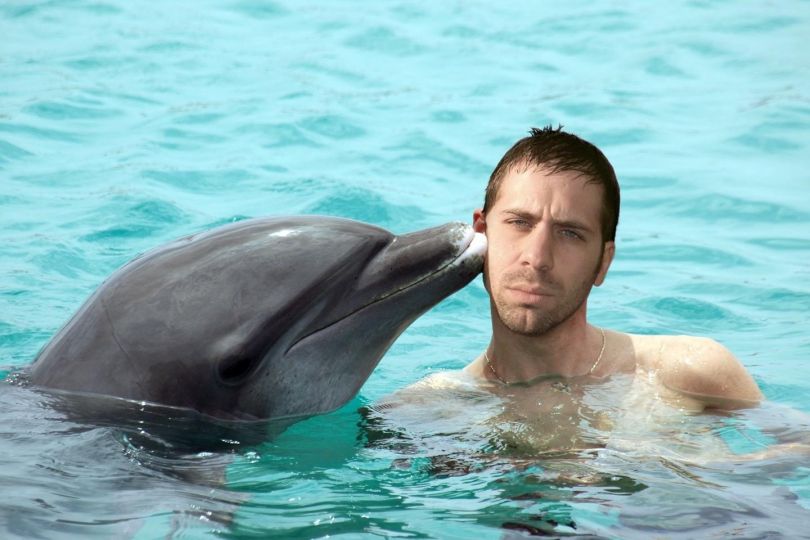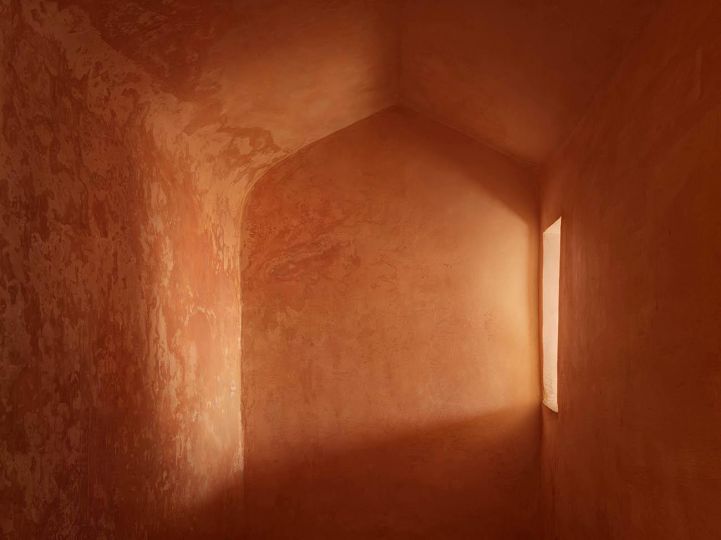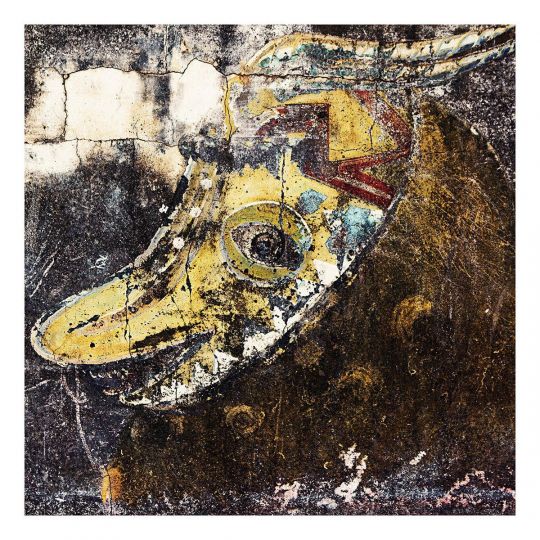Galerie Bart: Marleen Sleeuwits (images 1-2)
During Unseen Amsterdam 2022 we are presenting the newest body of work by Marleen Sleeuwits in a solo presentation which will consist of seven photos, based on three site specific installations she made in 2021: at the Kunsthal in Rotterdam, at Expo Bart in Nijmegen and at a ppr oc he in Paris. All photos will premiere at Unseen Amsterdam.
Multi-disciplinary artist Sleeuwits (1980,NL) has a keen eye for the disconcerting quality of seemingly mundane, everyday spaces. Central to her work is the examination of impersonal environments – places that could simultaneously be everywhere and nowhere. Marleen’s artistic practice gradually evolved from photographing these spaces to intervening with them. She frequently reuses location-specific materials in her installations, such as panels from dropped ceilings, carpet tiles, fluorescent lighting tubes and glass wool. She plays with perspectives, optical illusions and scale. In recent works, she has increasingly blurred the line between her 2D photo and her spatial art, with the result of calling into question the visual aspect of reality.
For the installation ‘Isomatrix’ at the Kunsthal Marleen was guided by the architecture of the building, designed by Rem Koolhaas, in which she discovered elements of beauty and disorientation. By amplifying these aspects she deliberately blurred the boundaries between fiction and reality. Windows that extend into the ceiling or architectural details that are repeated; Sleeuwits transforms the experience of the space by varying with scale and adding mirrors. In the photographs of the installation shown at Unseen, the materials of the installation are reused, again creating confusion: what is part of the photograph, and what is the real material?
Galerie Bart
1016 TW Amsterdam
+31 20 320 62 08
[email protected]
www.galeriebart.nl
Galerie Caroline O’Breen: Satijn Panyigay, Jaya Pelupessy & Arjan de Nooy. (images 3-4)
Satijn Panyigay
Gallery O’Breen presents the new part of Twilight Zone, an extensive photographic project for which Satijn Panyigay captures empty exhibition spaces of the Dutch contemporary art museums. She takes her photographs during solitary, meditative explorations of the temporarily empty museum spaces — this time, at FOAM in Amsterdam. Twilight Zone (FOAM) has the recognisable majestic hyper-realistic aesthetic of Panyigay, yet this series offers a new tonality to the project. The images are warm and the seemingly white museum walls reveal themselves surprisingly colour-rich. Satijn works exclusively with the light available on the scene, and her analogue approach brings out a whole hidden range of colour to the surface which creates a lively series.
Jaya Pelupessy
Jaya Pelupessy is known for analysing and deconstructing historical reproduction techniques and using them in a new way to create an image. He is fascinated by how humanity increasingly observes the world through a camera lens. The title Manufactured Manual refers to the archival images that appear in this recent project. He creates a collage directly on the screen-printing screen using multiple exposures in different coloured layers. In this way, the screen is no longer a means of reproducing images but becomes the work of art itself. This is typical of Pelupessy’s working method in which the creative process is always evident in the finished product. At UNSEEN 2022, we are presenting a selection of his most recent collages from the series
Pelupessy’s work is also selected for the exhibition Unbound, further information can be found in today’s last contribution under the heading UNBOUND O’Breen
Arjan de Nooy
Arjan de Nooy will present his newest body of work Photology, based on the eponymous book (soon to be published). The title Photology is a merging of photography and logic (of game playing), but of course ‘logy’ also refers to the study of photography. This work aims to be a photographic overview with new series and alternative theories based on the history and theory of the medium. At UNSEEN 2022, various collages taken from the project will be shown for the first time. All work exists of found footage, re-photographed photos, postcards and other appropriated material. By giving this another context, a new meaning always related to photography itself is created in de Nooy’s work.
Arjan de Nooy is mainly known for his book-making and museum shows, mostly with his partner Anne Geene. Together they made several award-winning books
Galerie Caroline O’Breen
Amsterdam, The Netherlands
+31647104484
https://carolineobreen.com
galerie dudokdegroot: Marjolein Blom (1984), Fleur van Dodewaard (1983), Paul Bogaers (1961) & Ilona Plaum (1970) (images 5-6)
Marjolein Blom (1984) is a visual artist who lives and works in Amsterdam (NL). Her work results from a fascination for scientific theories about the inner workings of our universe like those of quantum physics and special relativity and the human desire to unravel the deeper layers of existence through science. She will present some works from her latest project and also new Book: Failing Forward. In this series Marjolein Blom touches on the core of what connects art, science, and life; that all are uncertain exercises with uncertain results.
Fleur van Dodewaard (1983) The Artist in Her Studio with elementary materials wood, paper, clay, tape, paint – Fleur van Dodewaard creates temporary compositions that play with the possibilities of photography, sculpture, and painting. Situated at the intersection of these disciplines, her work uses photography as the final result. Questions relating to the art object, discourses about the creative process and image making, and art historical references are fundamental to her investigations. They provide the terms of an ongoing tumbling and cross-relating of old and new images, objects, ideas, and forms.
llona Plaum (1970) creates installations in which she explores the experience of space and translates it into the flat surface. Starting from the third dimension, she is building an installation with natural objects in which the movement of organic life occupies a central position. These are treated with paint or a drawing pen and then photographed. A photographic diorama is created in which the fusion of different techniques and perspectives casts doubt on our perception. Nothing in her work is photoshopped, she leaves traces of her actions. With a photo she isolates something from the mobility of existence in which everything is changeable.
In the works of Paul Bogaers association and suggestion play an important role. Bogaers made name as one of the forerunners of the interest of artists in ‘vernacular photography’ and integration of found imagery in their work. As a starting point he used to take an image or object from one of his many collections, consisting of found snapshots, postcards and other pre-existing images, as well as his own photographs. By placing different images next to another, sometimes turning them for a quarter or completely upside down or framing them in particular ways, he invited the viewer to perceive surprising new links and meanings. Gradually he started to combine pictures with threedimensional objects & turns more and more into assemblages and installations.
galerie dudokdegroot
1016 ra amsterdam
00 31 6 15 475 473
[email protected]
www. dudokdegroot.nl
Galerie Écho 119 : Chieko Shiraishi, Elliott Verdier (images 7-8)
For this edition of Unseen, we would like to present two photographers working on memory. Even though the two artists work with radically different subjects and styles, they encounter similarities in the way they show memories fading and in their approach of photography as a way to work with memory.
Shimakage (Shadow of the Islands), by Japanese photographer Chieko Shiraishi, is a journey into Shiraishi’s memories. In her images, taken in the small islands surrounding Japan, we find ourselves transported to the border of reality and the world of dreams. Her photographs evoke the feeling of memories that, as time passes, fade away and become blurred. To express this feeling, Shiraishi uses “zokin-Gake”, a technique which involves applying oil paint on analog prints. Her images take us from the outside world to the inside world, revealing the wonder, the darkness and doubts that inhabit the photographer.
French photographer Elliott Verdier’s Reaching for Dawn series is the story of a piece of land on the shores of West Africa, where in the 19th century, the United States established its first colony, the Republic of Liberia. Of the bloody Liberian civil war (1989-2003) that decimated Liberia, its population does not speak. No proper memorial has been built, no day is dedicated to commemoration. The trauma carved into the population’s flesh is crystallized in the society’s weak foundations and bleeds onto a new generation with a hazy future.
The series explores the mechanisms of resilience and the invisible resorts of psychic traumas and memories of war.
Galerie Écho 119
75003 Paris, France
[email protected]
+33 (0)9 70 97 59 18
www.galerieecho119.com
Galerie Vriend van Bavink: Kadir van Lohuizen, Natascha Libbert & Stijn Elshuis. (images 9-10)
We present new work by Kadir van Lohuizen about the Netherlands as the world’s second largest food exporter. After series on the global consequences of sea level and the disappearance and capitalisation of the North Pole, van Lohuizen did not have to look any further than his own backyard to find a world as bizarre as it is surreal, which opened up for him after intensive lobbying.
Natascha Libbert shows the destructive and resilient power of nature in a series about the eruption of the Cumbre Vieja volcano on La Palma. From her little house where the volcanic ash is raining down, she enters a cinematic, ominous environment where the dark clouds, red glow and black precipitation reflect the contrasts in life and death, colour and the adaptability of man and nature.
Stijn Elshuis is showing a new sculptural photographic work about extinct plant species. With his works, Elshuis wants to show the viewer how history can be written and rewritten in a rapidly changing world. How dependent we are on nature and how hard we try to impose our will on it, with all the consequences that entails.
Galerie Vriend van Bavink
1012BJ Amsterdam The Netherlands
+31 613193603
[email protected]
http://www.vriendvanbavink.nl
Galerie Younique: Majo Guerrero & Javier Silva Meinel (images 11-12)
« Visions and Cosmos » was a first exhibition at the gallery of two peruvian photographers Majo Guerrero and Javier Silva Meinel in 2021. Like two different subjects the idea of presenting their works was treated as a universal proposal: their vision of the cosmos. Majo Guerrero specialised in ancient techniques of photography revealing and Javier Silva Meinel with his vintage silver photography, agreed to show their relationship with nature and humanity.
As Alexander von Humboldt in his book Cosmos: a sketch of a physical description of the universe, describes it as “the assemblage of all things in heaven and earth, the universality of created things constituting the perceptible world.” We emphasize this time, the subjective vision of Humboldt of the universe order, through the female side.
Saturn, his moons and his phases watched with the satellite Cassini-Huygens, revealed in carbon prints by Guerrero next to the portraits of different females that Silva Meinel encounters in his numerous journeys in Peru are an example of this variety and diversity of “stars” that compose their visions of the cosmos.
Galerie YOUNIQUE
75013 Paris, France
+33 6 26 76 36 33
[email protected]
http://www.galerieyounique.com
Galleri Kant: Susanne Wellm, Joakim Eskildsen, Torben Eskerod (images 13-14)
Susanne Wellm (b. 1965) was educated at The Royal Danish Academy of Fine Arts Schools of Architecture, Design and Conservation – She lives and works in Copenhagen, Denmark.
The primary object of my work has always been to capture experiences that are sensory; the small things I see and touch that give structure to my everyday life, things that strike a mood and bring shades to the way of life. In my work I am influenced by the art of film. In series of photographs I seek to convey the feeling, ambience or potential stories that I see in the objects, happenings and people around me. I often work with layers, mixing various techniques and different photographic media.
Joakim Eskildsen is a Danish photographer educated in Finland at Aalto University and one of the most published and recognized photographers to emerge from the Helsinki School. He is most noted for his documentary photographic monographs that take a very personal view in depicting communities on the fringes of society. Despite seemingly melancholic undertones, Eskildsen achieves an overwhelming closeness in his work, often by living alongside his subjects for long periods of time.
Joakim Eskildsen was born in Copenhagen in 1971 and currently lives in Germany. His work has been exhibited extensively around the world in both solo and group exhibitions.
Torben Eskerod was educated at the Aalborg University (1980-86) and has studied at Aarhus School of Architecture and Fatamorgana School of Photography in Copenhagen (1988-91). Eskerod’s projects find common ground in his interest for contemplation and spirituality. He is especially known for his portraits) in series like Equivalence (1995), Cassadaga (2000), Register – Life and Death Masks (2001), Friends and Strangers (2006) and Campo Verano (2008). His approach to the spiritual potentials for photography is further explored in the series Marselis (2012) and Can Lis (2013).
GALERI KANT
1264 COPENHAGEN DENMARK
+45 29 46 63 31
[email protected]
www.GALLERIKANT.DK
















